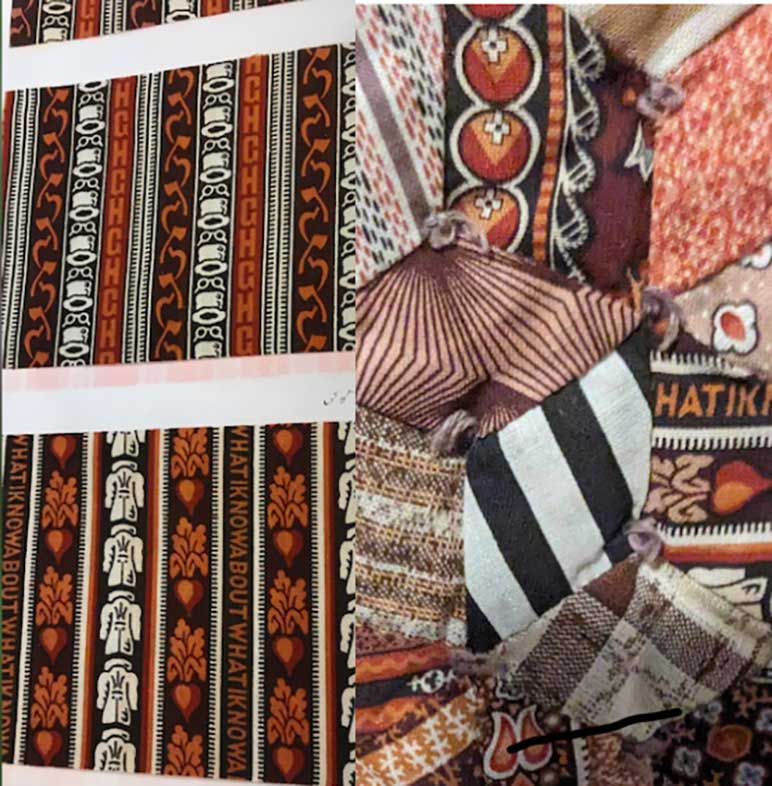February 2024
Covering Quilts
Journeys in quilt history: Political patchwork edition
by Sandra Starley
Learning about the past can be fun! One of the things that I love most about collecting antique quilts, blocks, and fabrics are all the interesting tidbits of history that I have gleaned along the way. I have learned about so many aspects of American history by studying fabrics and quilts in my collection. For example, from an 1850 Quaker signature quilt made near Philadelphia with a hand-drawn picture of a whale and a boat, I discovered that Quakers were prominent in the whaling industry. Similarly, from inkings of grapes on another signature Quaker quilt from the same era I learned that grape growing dated all the way back to William Penn. And during the mid-1800s Pennsylvania had a wine production boom. It is impressive what you can learn from quilts.
Recently, my friend Mea sent me a photo of some interesting antique fabric she had found on a new to her quilt. The quilt had tiny pieces, but she could see partial printed words or text on a couple of fabrics and thought I might have an idea about it. As luck would have it (or almost 20 years of antique fabric study), I immediately recognized it as a fabric that I had researched: Fabric that was related to famous politicians and United States presidential campaigns. I had found an intriguing antique printed fabric advertising the presidential campaign of Ulysses S. Grant with the text “US Grant, First in Peace and First in War” and “Let Us Have Peace” with a depiction of Grant. Interesting mix of war and peace slogans, but it was soon after the Civil War. Later, during a tour of the Manchester New Hampshire Historical Society with the American Quilt Study Group (AQSG), we were treated to a selection of antique swatch books from the local fabric mills. I was delighted to find another US Grant campaign fabric with the same slogan along with his 1871/1872 running mate Henry Wilson. I have yet to find either Grant fabric in a quilt, but my friend had found campaign fabric from Grant’s 1872 presidential opponent, Horace Greeley, in her quilt! And I had photographed that very fabric and several other Greeley fabrics in the same swatch book that had the Grant fabric. The fabric mill was covering all its bases and printing fabrics for both campaigns — an equal opportunity printing company for sure.

1871-72 Horace Greeley presidential campaign fabric
1871-72 Horace Greeley presidential campaign fabric. Left – fabric in New Hampshire swatch book. Right – fabric in Tumbling Block Quilt Top, private collection. (Image courtesy of the author)
The fabric she had found is interesting as it does not have Greeley’s name on it at all. Instead, the fabric features alternating stripes of his trademark heavy overcoat, beets (yes, beets), and the words “What I Know About.” Greeley authored a book called, “What I Know About Farming,” hence the text and the root vegetable. Another striped fabric from the same book features his signature top hat and glasses, along with his initials and farm equipment (axe and sickle). He was a newspaper editor and most famous for his entreaty “Go West, Young Man!” Greeley was not considered fashionable in 1871 and did not have the dashing bravado of General and incumbent President Grant. Greeley was relentlessly mocked by political writers of the time including cartoonist Thomas Nast of Harper’s Weekly. Do a search for Thomas Nast and Greeley to see the images. Grant prevailed and Greeley died soon after. His fabric lives on in swatch books and quilts as does that of President Grant. Political campaign fabrics are still being made and collected. Have you found any interesting fabrics lately?
Sandra Starley is nationally certified quilt appraiser, quilt historian, and avid antique quilt collector. She travels throughout the U.S. presenting talks on antique quilt history, fabric dating classes and trunk shows as well as quilting classes. Learn more at utahquiltappraiser.blogspot.com. Send your comments and quilt questions to SandraStarley@outlook.com

